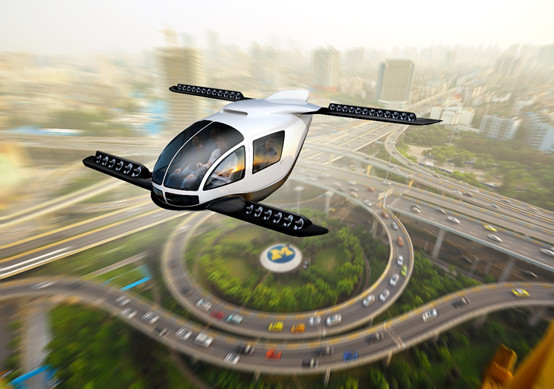 一辆电动垂直起降(eVTOL) 城市空中交通飞行器(UAM),也就是“空中出租车”正在城市中心上空飞行,图为渲染效果图。(图片来源:密歇根大学环境与可持续发展学院 Dave Brenner)
一辆电动垂直起降(eVTOL) 城市空中交通飞行器(UAM),也就是“空中出租车”正在城市中心上空飞行,图为渲染效果图。(图片来源:密歇根大学环境与可持续发展学院 Dave Brenner)
根据《自然通讯》杂志发表的一篇文章,电动垂直起降(eVTOL)城市空中飞行器(UAM),也就是大家所谓的“飞行汽车”将更适合行程较长的旅程。具体来说,这项有关“飞行汽车在可持续交通系统中角色”的研究由“密歇根大学可持续系统研究中心(Center for SustainableSystems)”和“福特汽车公司研究与高级工程团队”的工程师共同完成,是全球首份针对 UAM 系统可持续性的全面评估报告。
研究结果显示,在一些地理条件受限和交通环境拥挤的城市地区部署空中交通系统将大有裨益,尤其可以将其打造成共享交通服务的空中延伸。报告中指出,在类似“从旧金山到圣何塞”或从“底特律到克利夫兰”等较长行程中,满员情况下的 UAM 飞行器将比地面车辆更加高效。
通过来自多家 UAM 开发商的数据,研究人员发现,UAM 飞行器的耗能在起飞和爬升期间较大,但在巡航阶段很平稳,因此可以在一定程度“中和”完整行程的耗能情况。具体来说,在一次长约 62 英里的旅程中,一辆满载乘客的 eVTOL 飞行器的人均温室气体排放量低于普通私人汽车(后者平均乘坐 1.54 个人)低 52%,甚至比电动汽车低 6%。但速度却比小汽车快 80%。
密歇根大学可持续系统中心主任及资深作者 Gregory Keoleian 袒露,“我开始并没有想到 VTOL 飞行器在某些情况下的能源消耗和温室气体排放水平会具有竞争力。”
然而,研究人员同时发现,对于 22 英里以下的旅程,私人汽车比 UAM 飞行器的油耗更低、排放更少且速度也更快。报告指出,地面车辆的平均通勤距离为11 英里。
“因此,在地面车辆全年总行驶里程中,VTOL 飞行器仅在极少数场景下比地面车辆更具有可持续性优势。”研究作者 Jim Gawron 表示,“因此,VTOL 飞行器在可持续交通系统中的贡献和作用均将相对有限。”
此外,该研究还同时覆盖了电动 UAM 飞行器配套基础设施的排放和发电情况,比如 UAM 飞行器充电站等。
“我们可以将 VTOL 飞行器的可持续发展目标和商业案例相互协调起来,”研究作者 Akshat Kasliwal 表示,“提高乘客满员率不仅有利于降低人均排放,而且还可以优化飞行器的经济性。此外,考虑到飞行器可以帮助乘客节省大量时间,因此乘客可能将采用共享行程的方式。”
《飞行汽车在可持续交通系统中的作用》(Role of flying cars in sustainable mobility)一书的作者承认,在技术真正可行之前,我们还需要解决 UAM 通勤的用户成本、噪音污染和“社会和消费者接受度”等难题。
According to a new study published in Nature Communications, electric vertical takeoff and landing (eVTOL) urban air mobility (UAM) vehicles – commonly referred to as “flying cars” – are better suited to longer flights than shorter commutes. The study, “Role of flying cars in sustainable mobility,” was authored by engineers from the University of Michigan’s Center for Sustainable Systems (CSS) and from the Ford Motor Company’s Research and Advanced Engineering team and is the first comprehensive sustainability assessment of UAM.
The authors determined that deploying UAM systems in geographically constrained and congested urban areas would be beneficial, especially as part of a ride-share service – citing that fully-booked UAM vehicles would be more effective than ground vehicles in transporting passengers “from San Francisco to San Jose or from Detroit to Cleveland.”
Using data from several UAM developers, the authors found that through efficient cruise phases of the flight envelope, UAM vehicles made up for the energy expended during takeoff and climb. For a 62-mile trip, an eVTOL UAM vehicle full of passengers emitted 52 percent less greenhouse gas than a typical personal automobile (and 6 percent less than an electric automobile) with an average occupancy of 1.54 people. UAM vehicles also completed the 62-mile example route 80 percent faster than a personal automobile.
“To me, it was very surprising to see that VTOLs were competitive with regard to energy use and greenhouse gas emissions in certain scenarios,” says Gregory Keoleian, senior author and director of University of Michigan’s CSS.
However, for trips under 22 miles, the researchers found that single-occupant automobiles used less energy, expended less greenhouse gas emissions, and completed the route quicker than UAM vehicles. According to the study, the average ground vehicle commute is 11 miles.
“As a result, the trips where VTOLs are more sustainable than gasoline cars only make up a small fraction of total annual vehicle-miles traveled on the ground,” says study author, Jim Gawron. “Consequently, VTOLs will be limited in their contribution and role in a sustainable mobility system.”
The study also accounted for emissions and power generation for electric UAM vehicle infrastructure like charging stations.
“With these VTOLs, there is an opportunity to mutually align the sustainability and business cases,” says study author, Akshat Kasliwal. “Not only is high passenger occupancy better for emissions, it also favors the economics of flying cars. Further, consumers could be incentivized to share trips, given the significant time savings from flying versus driving.”
The authors of “Role of flying cars in sustainable mobility” concede that user-cost of UAM transportation, noise pollution, and “societal and consumer acceptance” also need to be addressed before the technology becomes truly viable.
Author: William Kucinski
Source: SAE Automated & Connected Knowledge Hub
等级
打分
- 2分
- 4分
- 6分
- 8分
- 10分
平均分
- 作者:William Kucinski
- 行业:航空
- 主题:管理与产品开发质量、可靠性与耐久性安全性运输系统
